ISSN ONLINE(2319-8753)PRINT(2347-6710)
ISSN ONLINE(2319-8753)PRINT(2347-6710)
A.Prasannah Rajasingh1, S.Rajkumar2
|
| Related article at Pubmed, Scholar Google |
Visit for more related articles at International Journal of Innovative Research in Science, Engineering and Technology
Networks-on-chip (NoCs) have emerged as a promising on-chip interconnect for future multi/many-core architectures as NoCs are able to scale communication links with the growing number of cores. In this paper, we present an adaptive route allocation algorithm which provides a required level of QoS (guaranteed bandwidth) coupled with an adaptive buffer assignment scheme which reassigns buffer blocks up-demand.Inaddition, the adaptivity requires a comprehensive, hardly invasive, runtime discernibility infrastructure, i.e., using supervising components, in order to collect data on the system put forward. The area overhead brought in by the adaptive scheme can be traded off against the tractability acquired. furthermore, the area operating cost is also reduced by resource manifolding due to the on-demand buffer assignment at each output port (we achieved on an average 42% buffer saving in our experiments).The proposed network-On-Chip can be modelled using Verilog HDL and simulated using Modelsim software.
Keywords |
| Network on chip (NOC), Quality of Service (QOS), Bandwidth, Multi- Manycore. |
INTRODUCTION |
| Cartesian routing is a fast packet routing mechanism intended for geographic addresses and can effectively accelerate the packet routing process within a local or metropolitan environment. The wide area Cartesian routing described in this paper is an extension of the Cartesian routing algorithms designed to make the exchange of internet work packets between geographical regions potential. It also preceded a new hierarchical structure for the entire Internet. The proposed Internet is viewed as a hierarchy of networks consisting of routers. At the highest level of this hierarchy, maximum routers exchange packets between large geopolitical areas such as countries, states, or responsible areas. At the bluest level of the structure, packets are routed between local routers in small geographical regions ranging from an office to a small town. There are only four layers in this structure and at each layer Cartesian routing is employed to send packets from the source router to the destination.The wide-area Cartesian Routing algorithm overcomes these problems by creating a hierarchical network consisting of two or more layers. Each network at a given layer comprehended one or more networks. Each network, regardless of its layer, employees the Cartesian Routing algorithm for packet routing. Two extensions to the original Cartesian Routing algorithm are required:each network (except for the highest) requires an internet work router that can direct packets destined for other networks “up” to the encompassing network. The address structure reflects the structure of networks, with specific fields in the address linked up with each layer. |
CARTESIAN NETWORKS |
| A Cartesian network comprises of a set of collectors and one or more arterials. |
 |
| Each collector is a chain of collectorrouters running east-west and sharing a common latitude. Collector routers have two side ports (east and west) to exchange packets’ horizontally’. Each and every collector router also has a bottom Port which permits it to connect it to local hosts. Arterials exchange packets among collectors. Each arterial router, exclude the most northerly and the most southerly has, at any rate, four ports (north, south, east and west). Arterials no need to share a common longitude. In a Cartesian network, the enforced topological structure relieves each router from maintaining lookup tables. Each router is limit to a unique pair of addresses, the state entropy is minimal, and each router maintains the accessibility of arterials to its west and east. |
| A .Cartesian Network Initialization |
| In Cartesian routing, each arterial issues Arterial This Way (ATW) control packets during its initialization process. An ATW tells the receiving collector router if an arterial is accessible through the incoming port. An ATW also specifies what kind of connection is accessible via the incoming port: north, south, north and south or neither. Supported by receiving an ATW, each collector router modify its Arterial Direction Indicator (ADI) and forwards the ATW to the opposite port. ATWs are also used to launchVirtual Arterials, constructed insituations where it is physically impossible for an arterial to span two collectors. The ADI points in the directionof the arterial router (i.e., east or west) and indicates whether the arterial router has a connection to thenorth, the south, or both. Figure 1 illustrates a Cartesian network. |
| B .Cartesian Routing |
| Packets can arrive on either a west or east port of a collector router. Packets meant for different latitude are forwarded out the opposite port from which they are received. The ADI decides the packet’s initial direction on the collector router when a packet arrives on the bottom port of a collector router. |
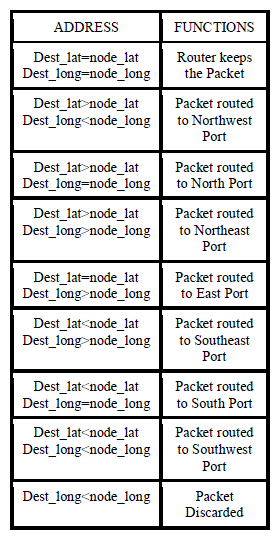 |
| In deciding a packet’s initial direction, the router first equates the packet’s destination address with its own address. The packet will be forwarded in the direction of the destination if the destination latitude is the same as the collectors. The packet is forwarded in the direction of the ADI if the destination is on different latitude. |
| C. Wide Areas Cartesian Networks |
| A Cartesian network provides a straightforward topological structure that relieves collector routers from the need to maintain lookup tables. However, it would be impossible to implement a single worldwide Cartesian network. Such a widespread Cartesian network,for example, expects every packet destined for a router with the same latitude identifier as the source router’s latitude identifier to visit all the collector routers. It is also necessary for such a network to have one collector for every possible latitude. These restrictions evoke that implementing a single worldwide Cartesian network would be impractical. A substitute to a worldwide Cartesian network is to create a set of smaller Cartesian networks and implement a mechanism for interchanging packets between them. One approach to interchanging packets between Cartesian networks is to forward packets towards their destinations. When a packet reaches the boundary of a network it “falls off” the edge and is delivered to a special router to be forwarded towards the destination address. The procedure of routing a packet from one network to another using this approach becomes problematic when networks are interleaved or overlapped. Two networks are considered interleaved if there is at least one collector router on one of the networks where its longitude identifier lies between the longitude identifiers of two collectors from the other network and its latitude identifier lies between the latitude identifiers of two collectors from the other network. Fig 2 illustrates two interleaved networks. Two networks are said to be overlapped if there is at least one collector router on one of the networks where its longitude identifier lies between the longitude identifiers of two collectors from the other network and all three of them share the same latitude identifier. Fig 2 illustrates two overlapped networks. |
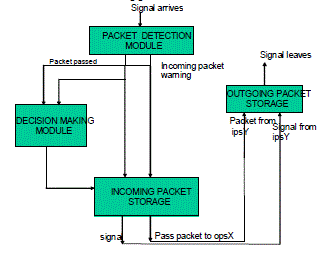 |
| An alternative method for delivering a packet to its destination is to find the destination network address and then to route the packet to the destination network by using Cartesian routing algorithms. This implies that each network must be identifiable using the packet’s destination address. If we assume that each network has a rectangular shape, identifying the destination network is a matter of comparing the packet’s destination address with the network’s boundaries. Nevertheless, there are a number of reasons to assume that it would be unrealistic to expect networks to have rectangular borders: geographical barriers and political jurisdictions, for example. Since Cartesian routing use latitude and longitude pairs to identify the source and the destination addresses of packets, this information is not sufficient to determine to which network a collector/arterial belongs in the case of interleaved and overlapped networks. This successively suggests that an additional set of information is required to identify to which network a collector or arterial is connected. To accomplish this, let us propose a hierarchical structure for Cartesian networks. In the next section, the hypothesis of multiple-layer Cartesian networks as a solution for interchanging packets between arbitrary shaped interleaved and overlapped Cartesian networks is explained. In the remainder of this paper, the terms “wide area Cartesian networks” and “multiple-layer Cartesian networks” are used interchangeably. |
WEIGHTED ROUTING ALGORITHM |
| To provide bandwidth guarantees in AdNoC, the underlying communication infrastructure needs to provide an adaptive route allocation scheme motivated from the adaptive routing schemes for large scale networks. In a physically static NoC, the routing decision can be distributed or a sourcebased deterministic routing scheme may be employed. In a distributed deterministic routing system, the routing decision is determined locally at each router using predefined rules, e.g., XY-routing algorithm in the QNoC [4] architecture. Thesource-based deterministic routing scheme (e.g., Xpipe [1]) keeps the complete route in the header of transaction packets and needs the global view of the whole chip before execution or even at design time. That is why both schemes are not suitable for the AdNoC architecture where the subset of tasks and their mapping may change during runtime. For a requesting transaction, the route is checked in every possible direction. The weighted XY-routing (wXY-routing) algorithm presented in Fig. 3 assigns each output port a weight based on available bandwidth and dx and x coordinate (columns) distance or dy,the y coordinate (rows) distance between the current and the destination node. This ideally gives the packet a maximum number of sensible routing choices along its route as it allows the packet to be routed toward its destination in both the x and y directions. The weight is also proportional to the available bandwidth. If the output port is chosen with the highest associated available bandwidth, the used bandwidth is distributed as evenly as possible among the output ports. Thus, the other output ports are more likely to be able to accommodate future transactions. By allowing both values to contribute to the weight, the weight becomes a tradeoff between these two considerations. The weights of each port are given as: |
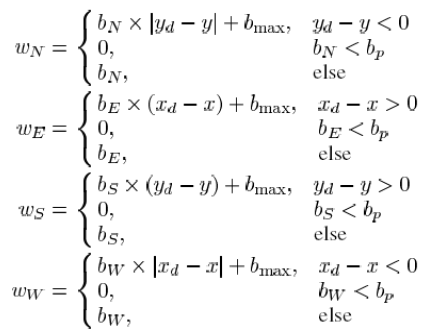 |
| They are calculated to be proportional to the distance from source to destination and to the available bandwidth if the output direction is facing the destination, and proportional to the available bandwidth if it is not.If there is not enough bandwidth available, the weights are zero. The route chosen is then to the direction with the highest weight. |
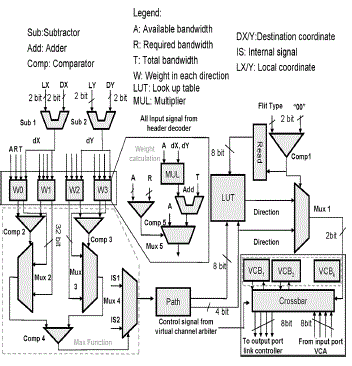 |
SIMULATION RESULTS |
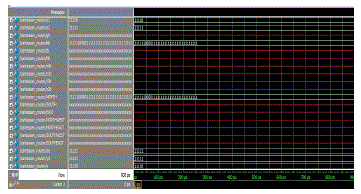 |
CONCLUSION AND FUTURE WORK |
| In Previous work, a conventional router which uses a routing table to determine whether to keep, forward or discard the packets. As networks grow in size, the memory requirements of the routing tables increases proportionately. The average search time increases as the routing table increases. We conclude that the AdNoC architecture enjoys the freedom to adapt during runtime and may very well increase the rate of successful transactions for changing network compared to applicationspecific/ design-time parameterized static generalpurpose NoCs. Static NoCs are fixed as far as buffer assignment is concerned and they cannot change their configuration and placement of virtual connections. |
| In future,the error correction can be detected and corrected between packet transmission in Network on Chip by the use of ECC. |
References |
|